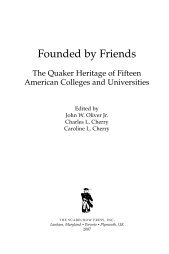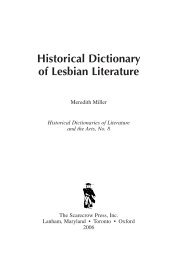Separate Realities: The Dream and the Iceberg - Scarecrow Press
Separate Realities: The Dream and the Iceberg - Scarecrow Press
Separate Realities: The Dream and the Iceberg - Scarecrow Press
You also want an ePaper? Increase the reach of your titles
YUMPU automatically turns print PDFs into web optimized ePapers that Google loves.
48 Chapter 2<br />
<strong>The</strong> existence of mixed forms of evidence where interest in class inequalities<br />
is concerned suggests that Americans generally lack a consistent focus on, or<br />
clear underst<strong>and</strong>ing of, <strong>the</strong> submerged dimensions of <strong>the</strong> class iceberg, including<br />
conflicting class interests, <strong>the</strong> structures <strong>and</strong> processes that legitimate<br />
<strong>the</strong> class system, <strong>and</strong> <strong>the</strong> possibilities for changing it. 12 We think <strong>the</strong> paradoxical<br />
trends of interest/concern <strong>and</strong> confusion/distraction stem, at least in part,<br />
from <strong>the</strong> taboo nature of social class in America.<br />
SOCIAL CLASS: THE LAST TABOO<br />
Class is <strong>the</strong> last great taboo. <strong>The</strong>se days it’s more socially acceptable to talk<br />
about sex than it is about . . . class.<br />
—Felice Yeskel, “Class Action in <strong>the</strong> News,” April 1, 2006<br />
Mainstream American social institutions today openly address a wide range of<br />
issues that until recently have been considered taboo as topics for public discussion.<br />
Despite <strong>the</strong> exp<strong>and</strong>ing inventory of previously censored cultural <strong>and</strong><br />
lifestyle issues (e.g., sexual orientation, abortion, rape, family violence, race<br />
<strong>and</strong> gender inequalities), social-class analysis remains <strong>the</strong> last taboo. This is especially<br />
<strong>the</strong> case for analyses involving <strong>the</strong> nature <strong>and</strong> consequences of socialclass<br />
structures, interests, <strong>and</strong> power inequalities. Examples of topics excluded<br />
from consideration by conventional social institutions under <strong>the</strong> taboo include<br />
inquiries into <strong>the</strong> one-sided class war waged by <strong>the</strong> superclass against <strong>the</strong><br />
working class, interpretations of working-class economic <strong>and</strong> political interests<br />
as legitimate, <strong>the</strong> merits of a labor party, <strong>and</strong> <strong>the</strong> need for new redistribution<br />
policies developed by <strong>and</strong> for <strong>the</strong> new working class that would shift substantial<br />
privileged-class economic <strong>and</strong> political resources to workers. Where<br />
<strong>the</strong>se <strong>and</strong> o<strong>the</strong>r features of class analysis are concerned, a virtual blackout exists<br />
among mainstream social institutions. Few public forums exist for wideranging<br />
discussions of <strong>the</strong>se topics, <strong>and</strong> <strong>the</strong>y have been consistently marginalized<br />
<strong>and</strong> ignored by <strong>the</strong> schools, <strong>the</strong> mass media, <strong>and</strong> most political leaders.<br />
Despite occasional media attention to some class-related lifestyle issues <strong>and</strong><br />
economic inequalities—as discussed later in this section, in <strong>the</strong> box at <strong>the</strong> end<br />
of this chapter (“Class Issues in <strong>the</strong> Media: <strong>The</strong> American <strong>Dream</strong>”), <strong>and</strong> in<br />
chapter 5—<strong>the</strong> taboo against social-class analysis remains firmly in place.<br />
Class analyses involving <strong>the</strong> issues noted above are not curricular <strong>the</strong>mes<br />
covered in schools at <strong>the</strong> primary or secondary level <strong>and</strong> are seldom included<br />
in university-level courses. 13 In <strong>the</strong> mainstream media, we find attention to<br />
working-class interests to be virtually nonexistent. In <strong>the</strong> print media, newspaper<br />
editors have little interest in, or sympathy for, working-class interests or<br />
issues. Majorities ranging from 54 percent to 60 percent of editors report that<br />
<strong>the</strong>y side with business in labor disputes <strong>and</strong> also in business-worker conflicts<br />
involving issues such as minimum-wage increases <strong>and</strong> plant-closing legisla-
















